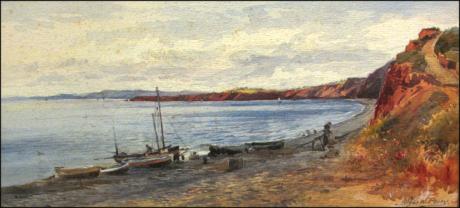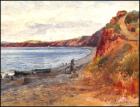lower right " Arthur W Perry"
Budleigh Salterton is a small town on the coast in East Devon, England, 15 miles south-east of Exeter. It is situated within the East Devon Area of Outstanding Natural Beauty. It is a major part of the electoral ward of Budleigh. The ward population at the 2011 census was 5,967. Budleigh Salterton lies at the mouth of the River Otter, where the estuary forms an area of reed bed and grazing marsh: an important haven for migratory birds and a Site of Special Scientific Interest for those interested in bird watching. It has a designated area for naturists. Budleigh Salterton lies on the South West Coast Path, with clifftop routes eastwards to Sidmouth and westwards to Exmouth. The pebble beach and cliffs are part of the Jurassic Coast World Heritage site.
Budleigh Salterton Anglicans were originally served by a chapel of ease that came under the parish of All Saints, East Budleigh. As the population grew, this was replaced in the 1890s by what became the parish church of St Peter in 1901. The church was heavily damaged by enemy aircraft bombing on 17 April 1942, but reopened in 1953. Today the Raleigh Mission Community at St Peter’s, Budleigh Salterton, and All Saints, East Budleigh, are part of a joint mission with St Michael’s, Otterton. The Roman Catholic Church is also dedicated to St Peter. The Temple Methodist Church was completed in 1904, to replace an earlier, smaller chapel dating from 1812, built by the bookseller James Lackington, an associate of John Wesley. There is a Baptist church in the town, whose congregation dates back to 1843.
The heart of Raleigh Country could be said to be East Budleigh, because in 1552 the renowned Elizabethan Sir Walter Raleigh was born here in the farm that is now known as Hayes Barton. The Raleigh family had settled here in 1537 and soon became involved in the village community. Walter’s father was a church warden of the Church of All Saints at East Budleigh and the oldest memorial in the church is one to the memory of Joan the first wife of Walter’s father. The Raleigh pew on the left side of the nave is dated 1537. Walter must have spent many of his boyhood days in Budleigh Salterton, and possibly acquired his love of the sea from the time he had in the company of fishermen on the beach there. Budleigh Salterton was made famous by a painting by Sir John Everett Millais. His picture ‘The Boyhood of Raleigh’ was painted from the Octagon, situated in Fore Street. The ancient wall featured in the background of the painting still stands today!
The seaside settlement that is now Budleigh Salterton for generations derived its livelihood from agriculture, fishing and a bit of smuggling on the side. Doomsday records that salt panning was of great importance here, hence the origin of the name ‘Salterton’ and the remnants of a fine Roman villa near Otterhead suggests that this activity went on as far back as Roman or even Iron Age times. Up to the early 16th century, the River Otter was navigable as far as Otterton. The river was then a scene of considerable activity as the area, and East Budleigh in particular, played an important part in the continental trade. The village of East Budleigh, then a thriving town, was concerned with the production and dyeing of wool and enjoyed prosperity when Budley Haven, on the left bank of the Otter operated as a port. There was also some shipbuilding activity.By Tudor times the build up of sand and the pebble bank at Otter mouth caused the gradual silting up of the river. A subsequent industrial activity at Otter mouth was the production of lime for use in agricultural and building. Up to 1875 three kilns were in operation by the side of the river.
Budleigh Salterton, formerly Salterton or Salterne, derives its name from the manufacture of salt in large salt pans which were constructed at the lower part of the River Otter, just before it emerged into the sea. They belonged to the priory of Otterton, and the monks had charge of the salt makers and of the pack-horses by which the salt was conveyed to the various townships and hamlets along the course of the river. Salt was the only food preservative used at that time. The pans were used as late as the 18th Century. Meanwhile, another thriving ‘industry’ in the area during the 18th century was smuggling!
The 18th century fashion for enjoying genial climates and taking salt water cures benefited several nearby towns, such as Sidmouth. Exmouth, Dawlish and Teignmouth. By the mid 19th century these were flourishing ‘health resorts’ but Budleigh Salterton was still very much a seaside village. However the coming of the railway at the start of the 20th century gave a considerable boost to its popularity as a resort and by 1920, the number of houses in the town outnumbered the totals of neighbouring Newton Poppleford, Colaton Raleigh, Otterton and East Budleigh. If you look through the archives at Fairlynch Museum you will find an interesting number of talented people have come as visitors or residents to our special town and helped to make it what it is today – Raleigh and Simcoe, Millais, Edward VIII (as Prince of Wales), Prince Edward, Rider Haggard and H.G. Wells. Adolphes Trollope, Sir Richard Rodney Bennett,Stuart Hibberd, Belinda Lee, Reg Varney and Sally McNally. In more recent years other famous and talented residents include Sue Lawley, Andrew Marr and twice Man Booker Prize winner Hilary Mantel.
Salem Chapel, East Budleigh, Devon The Salem Chapel in East Budleigh, an old Dissenters Chapel, is well worth a visit.It was built in 1719 on the edge of the village, at a time when there were about 30 dissenters in East Budleigh alone. It has had a colourful history in which smuggling played no small part. The minister from 1768 to 1807 was Samuel Leat who is reputed to have been a wealthy smuggler, and following his death in 1817 a scandal developed involving embezzled funds and the suspected suppression of his will. This culminated in the desecration of his grave in May 1818 when the grave was opened , the coffin wrecked and his body mangled.The roof of the chapel is of great archaeological interest, being of a unique construction which allowed the storage of smuggled goods in its massive attic and also gave the facility of a hidden vantage point where a lookout could be posted to forewarn of the coming of any Revenue Men.
With an Address at Prospect House, Seaton, East Devon, Perry exhibited and sold three paintings at the NAG in the Summer of 1906 including Seaton Bay. In 1907 also in the NAG he exhibited and sold Landslip and Icanthus. He painted in watercolour & specialised in landscape, coastal & village scenes. Many of his works were reproduced as hand coloured half tone postcards by Worth's Art Gallery in Exeter. He didn't exhibit widely, but did exhibit two works at the Royal Birmingham Society of Artists in 1908. His art shop in Seaton sold all kinds of art materials as well as his paintings. He doesn’t seem to have tried to exhibit his work. He died in 1948 and is buried in St Gregory’s churchyard.



